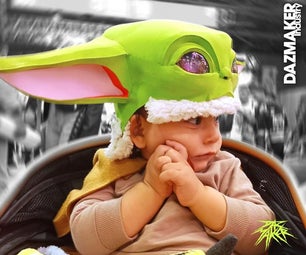Introduction: Cyberpunk Mask
Mask based on the aesthetics and style of the cyberpunk genre. This project can be time consuming and can be a bit expensive, so I recommend doing this project over the course of a couple days and with all the supplies in hand.
This project has a lot of expensive materials and tools can be replaced with cheaper alternatives. I will list any alternatives in the steps.
Supplies
Materials needed:
- (Optional for "expensive" version) 3D printer + Filament
- Cardboard
- EVA foam of differing thicknesses
- Mod Podge
- Premixed joint compound
- Styrene sheets
- Super Glue
Tools:
- (To cut 3D printed parts if using 3D printer) Saw
- Paint brush
- Hobby knife
- Sand paper
- Sanding Stick
- Dremel
- (To make markings) Pencil/Marker
- Respirator
Step 1: Eye Covering P1
I designed the eye covering for this project in Blender 3D, and then 3D printed the eye covering using a 3D printer using PLA. If u design your own mask, I recommend splitting up the mask into pieces so as to save filament and also hopefully lessen the chance of the prints failing. Once all the pieces have been printed, glue them all together. Files are linked below for use.
For a cheaper version of this eye covering, cardboard can be used. When doing so, make sure to stack up multiple layers of cardboard to have a stronger structure. Once done, premixed joint compound can be used to make the surfaces of the eye covering flatter. While wearing a respirator to protect your lungs from the dust created from sanding, sand down the compound to make the surface flat.
Attachments
Step 2: Other 3D Printed Parts
Attachments
Step 3: Eye Covering Modifications
I sanded down the inside of the eye covering, and also sawed off the lower area of the masks to create a better fit. If you design your own mask, you can skip this step.
Step 4: Eye Covering P2
Start adding details to the mask using EVA foam and styrene sheets. The thicker EVA foam can be used to block out the shapes of the mask (as I did in the photos above), then thinner layers of EVA foam can be used to make smaller details, and the styrene sheets used to add further details.
Additionally, the styrene sheets can be etched into using the hobby knife, and the gap further widened using sanding sticks. These gaps can be used to replicate panel linings and battle damage. Set these aside for later.
Step 5: Eye Covering P3
As in step 1, use the premixed joint compound to create flat surfaces. I recommend only covering the EVA foam in the compound, waiting for it to dry and sanding it, then putting any styrene details onto the compound after it has dried and been sanded. Scraps and 3D printed parts can also be used to further add detail.
Cover the eye covering in Mod Podge to seal everything in and protect it. I recommend 3-4 layers of the Mod Podge. Sand down the Mod Podge layers using high grit sand paper that is wet. However, don't sand down the layers completely, just enough to smoothen it out and remove the paint brush strokes.
Set aside the finished eye covering for later.
Step 6: Mask P1
Create the mask using cardboard. As before in step 1, create multiple layers of cardboard to make a stronger structure. Then, as in step 3, cover the cardboard in premixed joint compound to make the surface of the mask flatter. I recommend doing a few layers to get the best result. Make sure to sand down before each new application of the compound.
Step 7: Mask P2
Add details using the same process in step 2.
Step 8: Paint
Spray paint an initial layer of paint primer to create a good surface to paint on (I used a black paint primer). Try to keep the layers of paint as thin as possible and evenly covering the eye covering and the mask. If you don't have a spray paint primer, you can cover your mask and eye covering using white or black paint.
Step 9: Paint P2
Paint the mask and eye covering in whatever way you want. Paint them in a way that looks good and appeals to you. Once the paint has dried, cover the mask and eye coverings in a thin layer of mod podge to protect the paint.
Step 10: Glue on Styrene Sheet Details and 3D Printed Details
Paint up the small details, then attach them to the mask and eye covering.
Step 11: Make Eye "lens"
Using 4 thin circular plastic sheets and 2 sheets of thin fabric, you can make the lens for the mask. You can sandwich the fabric in between 2 of the 4 plastic sheets then insert it into the mask. Super glue the lens in place.
Step 12: Straps
Add straps to the covering and masks so that you can put them on, and then your done!
Step 13: Photos

Runner Up in the
Wear It Contest






















Comments
25 days ago
That's really impressive! Nicely done :D